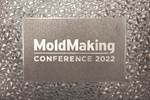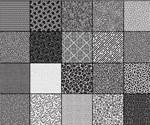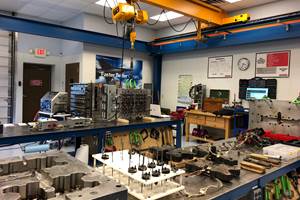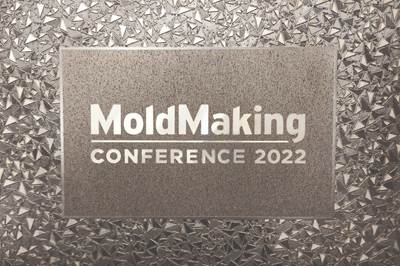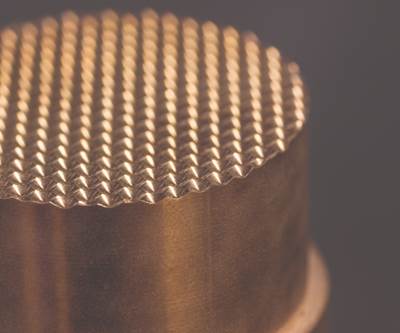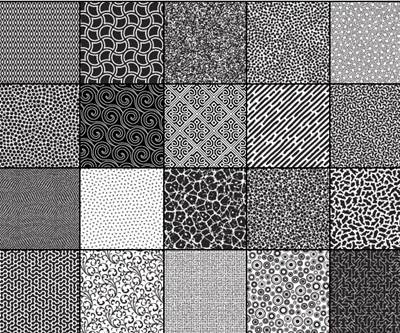
Ultra-fast femtosecond laser texturing technology opens the door to new approaches for electric vehicle (EV) lighting lens molds production. Source (All Images) | Microrelleus (Barcelona, Spain)
The electric vehicle (EV) industry is pushing the design and look of automotive lighting to the edge, so to speak. Instead of conventional headlights and taillights that use multiple bulbs behind specific-size lenses, EV designers are incorporating a new system known as edge-lighting to provide better-controlled lighting and enhanced vehicle visibility along with other design options in terms of aesthetics and functionality. However, the special lens patterns necessary for edge-lighting pose some unique moldmaking challenges that are only overcome with new, ultra-fast femtosecond laser texturing technology.
Solving Edge-Lighting Challenges Super Fast
Edge-lighting systems use internal LEDs around the edges to illuminate the entire lens cover, operating much like a fiber optic. What makes this possible is a special pattern of tiny channels or micro facets textured into the plastic lenses that refract the light. Unlike current vehicle lighting lenses, it is impossible to impart this new pattern onto a mold using conventional milling, chemical etching or even current nanosecond laser texturing processes.
Ultra-fast femtosecond laser texturing technology, on the other hand, creates new approaches to producing EV lighting lens molds as well as those for other applications. In a typical molding cycle, a shop begins by building a prototype of the metal mold. Then, they would apply the desired texture to it, mold the part and test it in an actual lighting assembly to ensure the lens performs as intended. If it doesn’t, they have to retexture the mold, produce another lens and test it again, all of which increase time and cost within the product development cycle.
Ultra-fast femtosecond laser texturing technology, on the other hand, creates new approaches to producing EV lighting lens molds.
UItra-fast femtosecond laser texturing generates nearly identical results — sharp facet feature edges without radii — in both plastic and steel workpiece materials. This enables mold builders to mold a test lens without any texturing on it, load the lens into an ultra-fast femtosecond laser texturing machine, apply the texture directly to the plastic lens itself and then test it. If the texture meets specifications, the shop can apply that texture onto the mold for production. This capability eliminates the need to produce a mold for testing and significantly shortens the product development cycle.
In early 2023, an ultra-fast femtosecond laser technology was launched as an option for a new laser texturing product line and some existing laser machine models. While moldmakers have been effectively texturing molds using nanosecond laser technology for quite some time, that type of laser is unable to generate pattern details in actual plastic parts that are as sharp and intricate as with an ultra-fast femtosecond laser.

Ultra-fast femtosecond laser texturing enables mold builders to texture plastic and steel workpieces with sharp facet feature edges, eliminating the need for pre-textured test lenses.
Understanding How it Works
What makes a laser ultra-fast is its pulse width. Essentially, laser texturing is machining with light, and when doing so, the process/application depends on how fast the laser’s beam turns on and off — its pulse width.
In sheet metal cutting, for example, the laser stays on constantly to cut. As it does, it creates heat, so for surface texturing, intermediate pulse speeds allow for material removal but without inducing excessive heat into the workpiece. With ultra-fast femtosecond lasers, the pulse on-and-off timing/speed is extremely fast and measured to a number that’s 15 decimal places of a second. Such speed also reduces the amount of heat transferred into the workpiece.
Nanosecond lasers typically used for mold texturing generate a heat-affected area and a melted raised portion or burr/deformation that’s about 20 microns in height. With conventional femtosecond lasers, there is no heat-affected area, and the burr measures only 0.2 micron. The less deformation there is, the more “crisp” the feature details and the smaller details can be generated.
Making the Switch
For over a year, an automotive supplier beta-tested the ultra-fast femtosecond laser technology in its actual operations. As a result of this technology, the company totally changed its business profile in terms of lighting production.
Prior to lasers, many automotive OEMs and their suppliers produced auto-lighting lens mold textures using milling, EDM or existing laser technology. However, as features/facets continue to shrink in size, those processes become less viable options, mainly because of the time and cost involved. This need for smaller, more precise details or extremely sharp facets like those required for EV lighting molds is the driver behind new technology such as ultra-fast femtosecond lasers.
Obviously, there is a cost involved with ultra-fast lasers. Nevertheless, a shop can have an ultra-fast laser texturing system and nanosecond laser as well — having both laser platforms and capabilities on one machine significantly increases a mold builder’s ability to expand its range of applications, making the initial investment well worth it.

Using ultra-fast femtosecond lasers, automotive mold builders can generate textures not only for standard interior component molds but also for new, intricate lighting systems.
For automotive work, these mold and die shops can generate textures not only for standard interior component molds but also for new, intricate lighting systems. These dual-platform machines would enable shops to switch back and forth between laser types and even do so within the same part program if needed.
Beyond EV edge-lighting applications, ultra-fast femtosecond lasers offer mold shops the ability to generate other sophisticated and unique end-product textures or finishes onto molds that were previously impossible or cost-prohibitive. These include brushed finishes, such as those often found on parts made from stainless steel or nickel and gloss finishes, used to reduce the appearance of smudges or fingerprints.
These are finishes that would otherwise be achieved through such processes as painting or powder coating. Eliminating or minimizing these secondary processes further reduces product development time and production costs while helping to differentiate end products.
Other potential applications include any part that requires functional textures, such as those used on medical implants. These surfaces are often key to osseointegration, where the bone fuses with the implant for greater stability.
The faster molds are made, the shorter the product development lead times and the quicker and more cost-effectively companies can get new products to market. This time and money savings mean companies will be more likely to develop even more new and unique products that will, in turn, require additional molds. Since turnaround time and costs are less, more companies will be willing to develop more products.
As this happens, technology suppliers continue to advance laser texturing technology, developing machines with more capabilities through advanced controls, software and laser sources. As a result, these laser texturing machines are faster and able to cost-effectively generate textures, including those that are impossible with other existing conventional processes.
(Data courtesy of Reichle Technologiezentrum, Teck, Germany and Microrelleus, Spain)
Related Content
Think Safety: Eliminate Hazards Throughout the Shop
The tooling community is taking advantage of new products for safer mold shops and molding facilities.
Read MoreLaser Welding Versus Micro Welding
The latest battle in finely detailed restoration/repair of mold materials.
Read MoreWhat You Need to Know About Hot Runner Systems and How to Optimize Their Performance
How to make the most out of the hot runner design, function and performance.
Read MoreRead Next
Five-Axis Laser Machining Makes Digital Mold Textures Possible
Mold manufacturers using laser technology can play a vital role in brand protection, recyclability and traceability efforts with new digital mold textures.
Read MoreFemtosecond Lasers Improve Mold Texturing and Micromachining
Newer femtosecond laser machine option solves common working distance challenge for micromachining and mold texturing.
Read MoreA Look at Mold Texturing
Laser texturing, if understood and appreciated, can open up the door to endless possibilities in texturing, according to this texture house.
Read More

